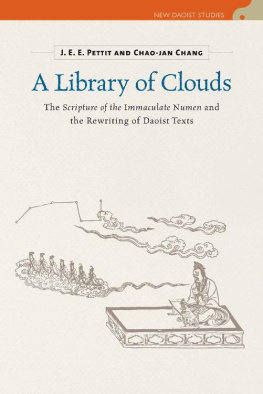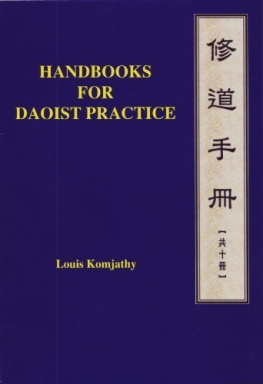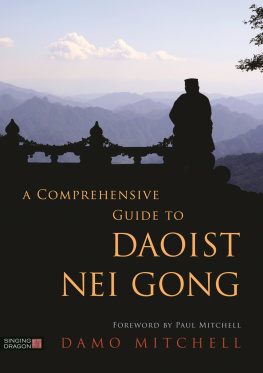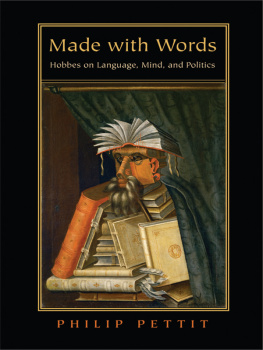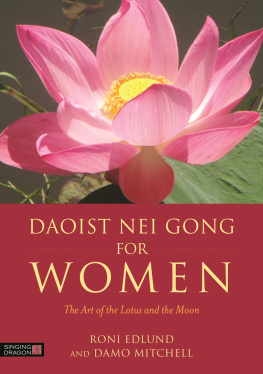J. E. E. Pettit - A Library of Clouds (New Daoist Studies)
Here you can read online J. E. E. Pettit - A Library of Clouds (New Daoist Studies) full text of the book (entire story) in english for free. Download pdf and epub, get meaning, cover and reviews about this ebook. year: 2020, publisher: University of Hawaii Press, genre: Religion. Description of the work, (preface) as well as reviews are available. Best literature library LitArk.com created for fans of good reading and offers a wide selection of genres:
Romance novel
Science fiction
Adventure
Detective
Science
History
Home and family
Prose
Art
Politics
Computer
Non-fiction
Religion
Business
Children
Humor
Choose a favorite category and find really read worthwhile books. Enjoy immersion in the world of imagination, feel the emotions of the characters or learn something new for yourself, make an fascinating discovery.
- Book:A Library of Clouds (New Daoist Studies)
- Author:
- Publisher:University of Hawaii Press
- Genre:
- Year:2020
- Rating:3 / 5
- Favourites:Add to favourites
- Your mark:
- 60
- 1
- 2
- 3
- 4
- 5
A Library of Clouds (New Daoist Studies): summary, description and annotation
We offer to read an annotation, description, summary or preface (depends on what the author of the book "A Library of Clouds (New Daoist Studies)" wrote himself). If you haven't found the necessary information about the book — write in the comments, we will try to find it.
A Library of Clouds (New Daoist Studies) — read online for free the complete book (whole text) full work
Below is the text of the book, divided by pages. System saving the place of the last page read, allows you to conveniently read the book "A Library of Clouds (New Daoist Studies)" online for free, without having to search again every time where you left off. Put a bookmark, and you can go to the page where you finished reading at any time.
Font size:
Interval:
Bookmark:

NEW DAOIST STUDIES
A Library of Clouds: The Scripture of the Immaculate Numen and the Rewriting of Daoist Texts By J. E. E. Pettit and Chao-jan Chang
2020 The Chinese University of Hong Kong
All rights reserved. No part of this book may be used or reproduced in any manner whatsoever without written permission. No part of this book may be stored in a retrieval system or transmitted in any form or by any means including electronic, electrostatic, magnetic tape, mechanical, photocopying, recording, or otherwise without the prior permission in writing of the publisher.
ISBN: University of Hawaii Press 9780824882921
ISBN: The Chinese University of Hong Kong 9789882371811
Published for North America by:
University of Hawaii Press
2840 Kolowalu Street
Honolulu, HI 96822 USA
www.uhpress.hawaii.edu
Published for the rest of the world by:
The Chinese University of Hong Kong Press
The Chinese University of Hong Kong
Sha Tin, N.T., Hong Kong
cup.cuhk.edu.hk
Library of Congress Cataloging-in-Publication Data
Names: Pettit, J. E. E., author. | Chang, Chao-jan, author.
Title: A library of clouds: the Scripture of the immaculate numen and the rewriting of Daoist texts / J. E. E. Pettit & Chao-jan Chang.
Other titles: Scripture of the immaculate numen and the rewriting of Daoist texts | 880-03 Dao zang. Selections. | New Daoist studies.
Description: Honolulu: University of Hawaii Press, 2020. | Series: New Daoist studies | Includes bibliographical references and index.
Identifiers: LCCN 2020022845 | ISBN 9780824882921 (cloth) | ISBN 9780824884376 (pdf) | ISBN 9780824884390 (epub) | ISBN 9780824884383 (kindle edition)
Subjects: LCSH: 880-01 Dao zang. | 880-02 Dao zang. Tai shang Suling Dong xuan da you miao jing. | Taoism.
Classification: LCC BL1920 .P47 2020 | DDC 299.5/1482dc23
LC record available at https://lccn.loc.gov/2020022845
New Daoist Studies aims to publish exciting new scholarship on the Chinese religion of Daoism. The series was initiated by Professor Lai Chi Tim, director of the Centre for Studies of Daoist Culture (CSDC), the Chinese University of Hong Kong (CUHK); and Professor Stephen R. Bokenkamp, Regents Professor of Chinese, Arizona State University. It is supported by CSDC, which is itself a joint undertaking of CUHK and the Daoist temple Fung Ying Seen Koon. Since 2006 CSDC has developed into the worlds most dynamic institution for learning about Daoism and for Daoist studies research and publishing. New Daoist Studies titles share the imprint of two presses: The Chinese University of Hong Kong Press and University of Hawaii Press. In the great spirit of Daoism, the series editors present this cooperative venture as a model for future collaborations.
10 9 8 7 6 5 4 3 2 1
Printed in Hong Kong
Chapter One: Thirty-One Fascicles:
Cataloguing Scriptures of the Heavens
Chapter Two: Three Ones:
A Stereoscopic View of a Daoist Hagiography
Chapter Three: Five Stars:
Remaking Daoist Ritual
Chapter Four: Nine Palaces:
Later Reconstructions of Upper Clarity
Chapter Five: Three Hundred Fascicles:
Rethinking the Authorship of Daoist Scriptures
A Library of Clouds is the first monograph devoted to the important Upper Clarity text the Scripture of the Immaculate Numen. Upper Clarity (Shangqing ), or Maoshan (), revelations designate a group of Daoist textsand the slightly later scriptures that imitate themthat were bestowed by deities upon the medium Yang Xi (33086 CE). The full title of the scripture treated in A Library of Clouds is Taishang suling dongxuan dayou miaojing (Most High Wondrous Scripture of the Immaculate Numen that Penetrates the Mystery of the Great Existence). Like other Upper Clarity scriptures, its name designates the celestial realms where the original work was thought to have been stored. Suling (Immaculate Numen) and Dayou (Great Existence) are the names of the room and palace, respectively, where the heavenly prototype of this text was kept.
The Upper Clarity scriptures have been of intense interest to scholars because they were collected and catalogued by the Daoist scholar Tao Hong-jing (456536 CE) and thus are roughly datable. Although Taos main compilation of Upper Clarity texts, the Secret Instructions for Ascent to Perfection (Dengzhen yinjue ), is mostly lost, his Declarations of the Perfected (Zhengao ) includes more general information and has provided modern researchers with a guide to the scriptures. Still, the fourth to seventh centuries saw a rapid proliferation of Daoist scriptures, both Upper Clarity texts and writings from other traditions. Scholarly debate on the relative priority of and connections among these works is intense. By deploying redaction criticism, a methodology seldom applied to Daoist writing, J. E. E. Pettit and Chao-jan Chang have found a way around the roadblocks to greatly advance our understanding of medieval Daoist scripture.
Redaction criticism is a congeries of methods developed to uncover the composition history of the Christian Bible. The methods center on an understanding of how premodern texts came into being through the work of one or more compilers rather than the pen or brush of a single author. Chang and Pettit modify redaction criticism to fit the Daoist case: They probe the different layers of an important scripture from the Upper Clarity lineage to demonstrate how Daoist authors of the fourth to seventh centuries each contributed strands to what is now a single scriptural fabric. Hence the jing (scripture) proves to be the work of not one but multiple authors, sometimes working in concert and sometimes attempting to correct one another. Through analyzing this process closely, Pettit and Chang show that, while other religious traditions held sacred writings as immutable, medieval Daoists considered their scriptures to be imperfect human approximations of celestial originals and often altered them in response to new findings.
In the case of the Scripture of the Immaculate Numen, Chang and Pettit argue that Wang Lingqi (fl. 404) was likely the works most prominent editor. We have known since the earliest modern studies of medieval Daoist scriptureChen Guofus (19142000) Daozang yuanliu kao (1949), for examplethat Wang was a forger of Upper Clarity texts, but A Library of Clouds is the first to offer evidence as to which scriptures might be the product of his revisions and how the editing process might have worked. It therefore provides us with a key to unraveling the proliferation of Daoist scriptures that appeared during the fifth and sixth centuries CE. Finally, but not least, A Library of Clouds includes a full, annotated translation of the Scripture of the Immaculate Numen.
In the present work we not only have a new account of the very meaning of jing in the early Daoist context, but also are introduced to methodologies that address questions of dating and authorship. Through meticulous textual analysis and close reading, A Library of Clouds sheds light on the processes of redaction and composition in medieval Daoism that might be applied to a number of undated and problematic texts. To quote the authors, a study of the Scripture of the Immaculate Numen offer[s] insights into the persons and institutions who reformulated these (Upper Clarity) texts andinto what they reflect about the changing norms and expectations of Daoists in this early period. In our view,
Font size:
Interval:
Bookmark:
Similar books «A Library of Clouds (New Daoist Studies)»
Look at similar books to A Library of Clouds (New Daoist Studies). We have selected literature similar in name and meaning in the hope of providing readers with more options to find new, interesting, not yet read works.
Discussion, reviews of the book A Library of Clouds (New Daoist Studies) and just readers' own opinions. Leave your comments, write what you think about the work, its meaning or the main characters. Specify what exactly you liked and what you didn't like, and why you think so.

